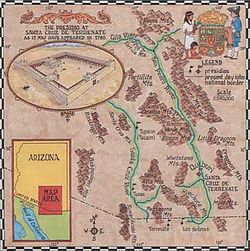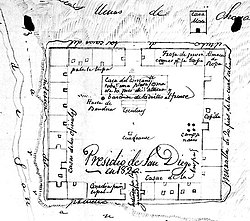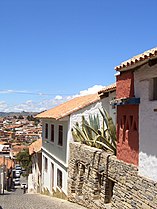Presidio

The Goliad presidio in Texas

The Cañada presidio in New Mexico

The Terrenate presidio in Arizona

The San Diego presidio in California
A presidio (from the Spanish, presidio, meaning "jail" or "fortification"[1]) is a fortified base established by the Spanish in areas under their control or influence.
The term is derived from the Latin word praesidium meaning protection or defense.
In the Americas, the fortresses were built to protect against pirates and rival colonists, as well as against resistance from Native Americans. In the Mediterranean and the Philippines, the presidios were outposts of Christian defense against Islamic raids. The presidios of Spanish-Philippines in particular, were centers where the martial art of Arnis de Mano was developed, combining Filipino, Latin-American and Spanish fighting techniques.[2] Later in western North America, with independence, the Mexicans garrisoned the Spanish presidios on the northern frontier and followed the same pattern in unsettled frontier regions like the Presidio de Sonoma, at Sonoma, California, and the Presidio de Calabasas, in Arizona.
In western North America, a rancho del rey or king's ranch would be established a short distance outside a presidio. This was a tract of land assigned to the presidio to furnish pasturage to the horses and other beasts of burden of the garrison. Mexico called this facility "rancho nacional".[3]
Presidios were only accessible to Spanish military and soldiers.
Contents
1 Mediterranean
2 United States
3 Mexico
4 Philippines
5 Further reading
6 References
Mediterranean
Italy:
- Estado de los Presidios
North Africa:
- Melilla
- Velez
- Oran
- Béjaïa
- Tripoli
Greece:
- Koroni
- Methoni
United States
South Carolina:[4]
- The Presidio Santa Elena, founded in 1566 on Parris Island, destroyed by Native Americans in 1576, re-established in 1577, abandoned in 1587
Georgia:[4]
- The Presidio Guale, founded in 1566, abandoned three months later
- The Presidio San Pedro de Tacatacuru, founded in 1569 on Cumberland Island, abandoned in 1573
Florida:[4]
- The Presidio San Augustin, founded in 1565, which developed into the city of St. Augustine, ceded to Great Britain in 1763 and regained 20 years later
- The Presidio San Mateo, founded in 1565 on the ruins of Fort Caroline, captured and destroyed by the French in 1568
- The Presidio Ais, founded in 1565 on the Indian River Lagoon, abandoned after one month
- The Presidio Santa Lucia, founded in 1565 near Cape Canaveral, abandoned four months later
- The Presidio San Antonio de Padua, founded in 1566 at Calos, capital of the Calusa, abandoned in 1569
- The Presidio Tocobago, founded in 1567 on Tampa Bay, destroyed by the Tocobagos within ten months
- The Presidio Tequesta, founded in 1567 on the site of what is now Miami, abandoned in 1568
- The Presidio Santa Maria de Galve, founded in 1696, near Fort Barrancas at present-day Naval Air Station Pensacola; captured by French in 1719, and the Spanish returned 3 years later. (See below, both Presidio Isla Santa Rosa Punta de Siguenza and Presidio San Miguel de Panzacola, which were established in the same general vicinity.)
- The Presidio Bahía San José de Valladares, founded in 1701 on St. Joseph Bay, captured by French in 1718. (See below, Presidio Bahía San Josė de Nueva Asturias.)
- The Presidio San Marcos de Apalachee, founded in 1718 at the existing port of San Marcos, which developed into the town of St. Marks, ceded to Great Britain in 1763 and regained 20 years later
- The Presidio Bahía San José de Nueva Asturias, founded in 1719 on St. Joseph Point, abandoned in 1722
- The Presidio Isla Santa Rosa Punta de Siguenza, founded in 1722 on Santa Rosa Island, abandoned in 1755
- The Presidio San Miguel de Panzacola, founded in 1755, which developed into the city of Pensacola, ceded to Great Britain in 1763 and regained 20 years later
Louisiana:
- The Presidio Nuestra Señora del Pilar de los Adaes, founded in 1721 near the present-day Robeline
Texas:
- The Presidio Fuerte de Santa Cruz del Cibolo, founded in 1734 and re-established in 1771 near Cestohowa, Texas in Karnes County, Texas, (between San Antonio and Goliad).
- The Presidio San Antonio de Bexar, founded in 1718 in San Antonio
- The Presidio Nuestra Señora de Loreto, founded in 1721, near Lavaca Bay, now in Goliad
- The Presidio of San Carlos de Cerro Gordo, founded in 1772 in Big Bend Country
- The Presidio San Luis de las Amarillas San Saba, founded in 1772 near the present-day Menard
- The Presidio de la Junta de los Ríos Norte y Conchos, founded in 1760 just southwest of present-day Presidio
New Mexico:
- The Presidio Santa Cruz de la Cañada, in Santa Cruz
Arizona:
- The Presidio San Ignacio de Tubac, founded in 1752 in Tubac
- The Presidio San Augustin del Tucson, founded in 1775 in Tucson
- The Presidio Santa Cruz de Terrenate, founded in 1775 near the present-day Tombstone
- The Presidio de Calabasas, founded in 1837 near the present-day Tumacacori
California:

Interior of the reconstructed chapel of the Santa Barbara Presidio
- The Presidio Real de San Carlos de Monterey, founded in 1770. Its rancho del rey was what became Rancho Nacional. It is currently housing the Defense Language Institute, in Monterey
- The Presidio Real de San Diego, founded in 1769 in San Diego, its rancho del rey was what became Rancho de la Nación.
- The Presidio Real de San Francisco, founded in 1776 and now part of the Golden Gate National Recreation Area in San Francisco. Its rancho del rey was what became Rancho Buri Buri.
- The Presidio Real de Santa Bárbara, founded in 1782 in Santa Barbara. Its rancho del rey was what became Rancho San Julian.
- The Presidio de Sonoma, founded by Mexico in 1836 in Sonoma. Its rancho nacional was what became Rancho Suscol.
Mexico
Presidios were established in frontier regions in northern Mexico to control and confine rebellious indigenous tribes.[5] Captured indigenous warriors were confined and enslaved at the presidio.[6]
Sonora:
- The Presidio de San Felipe y Santiago de Janos, founded in 1685 in Janos, Sonora
- The Presidio del Pitic, founded in 1726 in Hermosillo, Sonora
- The Presidio Santa Gertrudis del Altar, founded in 1755 in Altar, Sonora
- The Presidio de Santa Rosa de Corodéguachi, founded in 1692, near the Sonora/Arizona border and later moved to Fronteras, Sonora
- The Presidio de San Bernardino, founded in 1776 near the present-day Douglas (Gerald 1968)
Durango:
- The Presidio de Santa Catalina de Tepehuanes (1620 - 1690s?), in Santa Catarina de Tepehuanes.
- The Presidio del Pasaje (1685), on Rio Nazas northwest of Cuencamé.
- The Presidio de San Pedro del Gallo (1690s), in San Pedro del Gallo.
- The Presidio de Santiago de Mapimí (1715), in Mapimí.
- The Presidio de San Miguel de Cerrogordo (1648-1767) in Villa Hidalgo.
Chihuahua:
- The Presidio de El Paso del Río Grande del Norte (1683 - 1773), at Ciudad Juárez, across the river from El Paso, Texas. Later relocated south in 1773 to Carrizal.
- The Presidio de San Felipe y Santiago de Janos (1691-?), in Janos.
- The Presidio de Casas Grandes (1686), was relocated to Janos in 1691.
- The Presidio de San Francisco de Conchos, founded in 1685 at San Francisco de Conchos.
- The Presidio de San Bartolomé (? - 1710), located 20 km east of Parral. Replaced by flying squadron operating from the Post of Valle de San Bartolomé (1710 - ?).
- The Presidio de Nuestra Señora de las Caldas de Guajoquilla, founded in 1752 in Jiménez
- The Presidio de San Fernando de Carrizal (1758 - ?)
Coahuila:
- The Presidio del Santísimo Sacramento del Valle de Santa Rosa, founded in 1780 in Melcho Muzquiz, Coahuila
- The Presidio San Juan Bautista del Río Grande, founded around 1703 in San Juan Bautista, now the present-day Guerrero, Coahuila
- The Presidio San Antonio Bucareli de la Babia, founded in 1774 in present-day La Babia, Coahuila
- The Presidio San Gregorio de Cerralvo, founded in 1626 in Nuevo Leon, Mexico
Philippines

This is a map outlining the general locations of the Spanish "Presidios" built in the Philippines during the 1600s, according to the book Fortress of Empire by Rene Javellana, S. J. (1997)
Luzon:
- The Presidio de Santiago, founded in 1593 in Intramuros, Manila
- The Presidio de San Felipe (Cavite), founded in 1609 in San Roque, Cavite
Visayas:
- The Presidio (Fort) de San Pedro (Iloilo), founded in 1616 in Iloilo City
- The Presidio de San Pedro (Cebu), founded in 1630 in Cebu
Mindanao:
- The Presidio de Nuestra Señora del Pilar de Zaragoza, founded in 1635 in Zamboanga
Further reading
- Moorhead, Max L. The Presidio: Bastion of the Spanish Borderlands. Norman: University of Oklahoma Press 1975.
- Rene Javellana, S. J. Fortress of Empire. Ateneo de Manila University Press 1997.
References
Gerald, Rex E. (1968) Spanish Presidios of the Late Eighteenth Century in Northern New Spain. Museum of New Mexico Press, Santa Fe.
^ "presidio — Diccionario de la lengua española, Edición del Tricentenario". RAE (in Spanish). Retrieved October 28, 2017..mw-parser-output cite.citationfont-style:inherit.mw-parser-output qquotes:"""""""'""'".mw-parser-output code.cs1-codecolor:inherit;background:inherit;border:inherit;padding:inherit.mw-parser-output .cs1-lock-free abackground:url("//upload.wikimedia.org/wikipedia/commons/thumb/6/65/Lock-green.svg/9px-Lock-green.svg.png")no-repeat;background-position:right .1em center.mw-parser-output .cs1-lock-limited a,.mw-parser-output .cs1-lock-registration abackground:url("//upload.wikimedia.org/wikipedia/commons/thumb/d/d6/Lock-gray-alt-2.svg/9px-Lock-gray-alt-2.svg.png")no-repeat;background-position:right .1em center.mw-parser-output .cs1-lock-subscription abackground:url("//upload.wikimedia.org/wikipedia/commons/thumb/a/aa/Lock-red-alt-2.svg/9px-Lock-red-alt-2.svg.png")no-repeat;background-position:right .1em center.mw-parser-output .cs1-subscription,.mw-parser-output .cs1-registrationcolor:#555.mw-parser-output .cs1-subscription span,.mw-parser-output .cs1-registration spanborder-bottom:1px dotted;cursor:help.mw-parser-output .cs1-hidden-errordisplay:none;font-size:100%.mw-parser-output .cs1-visible-errorfont-size:100%.mw-parser-output .cs1-subscription,.mw-parser-output .cs1-registration,.mw-parser-output .cs1-formatfont-size:95%.mw-parser-output .cs1-kern-left,.mw-parser-output .cs1-kern-wl-leftpadding-left:0.2em.mw-parser-output .cs1-kern-right,.mw-parser-output .cs1-kern-wl-rightpadding-right:0.2em
^ "Real Fighting". Web.archive.org. 2008-02-21. Archived from the original on February 21, 2008. Retrieved 2015-12-01.
^ Ranchos of California: Extracts from: Grants of land in California made by Spanish or Mexican authorities, by Cris Perez Boundary Determination Office State Lands Commission Boundary Investigation Unit August 23, 1982. Berkeley Library website.
^ abc Childers, Ronald Wayne (2004). "The Presidio System in Spanish Florida 1565-1763". Historical Archaeology. 38 (3): 24–32. JSTOR 25617178.
^ "Spanish policymakers also decided to set up a line of presidios stretching from the Atlantic to the Pacific. This presidial line was very close to today’s international border between Mexico and the United States." Reséndez, Andrés. The Other Slavery: The Uncovered Story of Indian Enslavement in America (p. 198). Houghton Mifflin Harcourt. Kindle Edition.
^ "As the eighteenth century unfolded, military garrisons and soldiers superseded the missions as the lynchpins of Spain’s efforts to stabilize the frontier. With the new approach came new forms of coercion. The word “presidio” captures the dual purpose of garrison and prison." Reséndez, Andrés. The Other Slavery: The Uncovered Story of Indian Enslavement in America (p. 205). Houghton Mifflin Harcourt. Kindle Edition.

